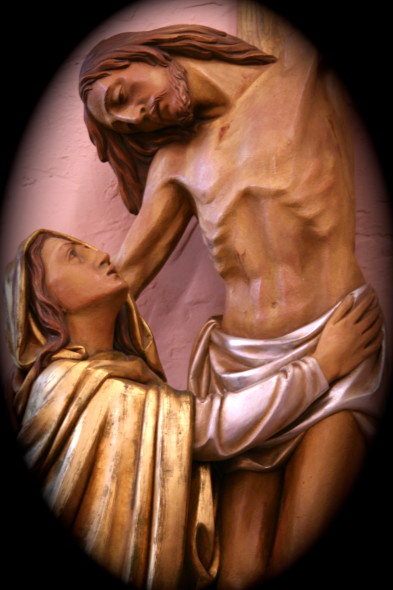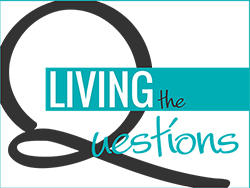We are almost at the end, my friends. Almost. And today’s passage is very long. It is the entire Passion Narrative, which is traditional reading for Good Friday. I encourage you to read it all the way through, in its entirety, and maybe do what I did — note the details. There are always details that I’ve missed, no matter how many times I’ve read or meditated on any biblical narrative, this one more than most. You’ll see the details that spoke to me — I’ve bolded them, just as I’ve done for the past 44 days.
John 18:1-19:42, The Living Bible
After saying these things Jesus crossed the Kidron ravine with his disciples and entered a grove of olive trees. Judas, the betrayer, knew this place, for Jesus had gone there many times with his disciples.
The chief priests and Pharisees had given Judas a squad of soldiers and police to accompany him. Now with blazing torches, lanterns, and weapons they arrived at the olive grove.
Jesus fully realized all that was going to happen to him. Stepping forward to meet them he asked, “Whom are you looking for?”
“Jesus of Nazareth,” they replied.
“I am he,” Jesus said. And as he said it, they all fell backwards to the ground!
Once more he asked them, “Whom are you searching for?”
And again they replied, “Jesus of Nazareth.”
“I told you I am he,” Jesus said; “and since I am the one you are after, let these others go.” He did this to carry out the prophecy he had just made, “I have not lost a single one of those you gave me. . . . ”
Then Simon Peter drew a sword and slashed off the right ear of Malchus, the High Priest’s servant.
But Jesus said to Peter, “Put your sword away. Shall I not drink from the cup the Father has given me?”
So the Jewish police, with the soldiers and their lieutenant, arrested Jesus and tied him. First they took him to Annas, the father-in-law of Caiaphas, the High Priest that year. Caiaphas was the one who told the other Jewish leaders, “Better that one should die for all.”
Simon Peter followed along behind, as did another of the disciples who was acquainted with the High Priest. So that other disciple was permitted into the courtyard along with Jesus, while Peter stood outside the gate. Then the other disciple spoke to the girl watching at the gate, and she let Peter in. The girl asked Peter, “Aren’t you one of Jesus’ disciples?”
“No,” he said, “I am not!”
The police and the household servants were standing around a fire they had made, for it was cold. And Peter stood there with them, warming himself.
Inside, the High Priest began asking Jesus about his followers and what he had been teaching them.
Jesus replied, “What I teach is widely known, for I have preached regularly in the synagogue and Temple; I have been heard by all the Jewish leaders and teach nothing in private that I have not said in public. Why are you asking me this question? Ask those who heard me. You have some of them here. They know what I said.”
One of the soldiers standing there struck Jesus with his fist. “Is that the way to answer the High Priest?” he demanded.
“If I lied, prove it,”Jesus replied. “Should you hit a man for telling the truth?”
Then Annas sent Jesus, bound, to Caiaphas the High Priest.
Meanwhile, as Simon Peter was standing by the fire, he was asked again, “Aren’t you one of his disciples?”
“Of course not,” he replied.
But one of the household slaves of the High Priest—a relative of the man whose ear Peter had cut off—asked, “Didn’t I see you out there in the olive grove with Jesus?”
Again Peter denied it. And immediately a rooster crowed.
Jesus’ trial before Caiaphas ended in the early hours of the morning. Next he was taken to the palace of the Roman governor. His accusers wouldn’t go in themselves for that would “defile” them, they said, and they wouldn’t be allowed to eat the Passover lamb. So Pilate, the governor, went out to them and asked, “What is your charge against this man? What are you accusing him of doing?”
“We wouldn’t have arrested him if he weren’t a criminal!” they retorted.
“Then take him away and judge him yourselves by your own laws,” Pilate told them.
“But we want him crucified,” they demanded, “and your approval is required.” This fulfilled Jesus’ prediction concerning the method of his execution.
Then Pilate went back into the palace and called for Jesus to be brought to him. “Are you the King of the Jews?” he asked him.
“‘King’ as you use the word or as the Jews use it?” Jesus asked.
“Am I a Jew?” Pilate retorted. “Your own people and their chief priests brought you here. Why? What have you done?”
Then Jesus answered, “I am not an earthly king. If I were, my followers would have fought when I was arrested by the Jewish leaders. But my Kingdom is not of the world.”
Pilate replied, “But you are a king then?”
“Yes,” Jesus said. “I was born for that purpose. And I came to bring truth to the world. All who love the truth are my followers.”
“What is truth?” Pilate exclaimed. Then he went out again to the people and told them, “He is not guilty of any crime. But you have a custom of asking me to release someone from prison each year at Passover. So if you want me to, I’ll release the ‘King of the Jews.’”
But they screamed back. “No! Not this man, but Barabbas!” Barabbas was a robber.
Then Pilate laid open Jesus’ back with a leaded whip, and the soldiers made a crown of thorns and placed it on his head and robed him in royal purple. “Hail, ‘King of the Jews’!” they mocked, and struck him with their fists.
Pilate went outside again and said to the Jews, “I am going to bring him out to you now, but understand clearly that I find him not guilty.”
Then Jesus came out wearing the crown of thorns and the purple robe. And Pilate said, “Behold the man!”
At sight of him the chief priests and Jewish officials began yelling, “Crucify! Crucify!”
“You crucify him,” Pilate said. “I find him not guilty.”
They replied, “By our laws he ought to die because he called himself the Son of God.”
When Pilate heard this, he was more frightened than ever. He took Jesus back into the palace again and asked him, “Where are you from?” but Jesus gave no answer.
“You won’t talk to me?” Pilate demanded. “Don’t you realize that I have the power to release you or to crucify you?”
Then Jesus said,“You would have no power at all over me unless it were given to you from above. So those who brought me to you have the greater sin.”
Then Pilate tried to release him, but the Jewish leaders told him, “If you release this man, you are no friend of Caesar’s. Anyone who declares himself a king is a rebel against Caesar.”
At these words Pilate brought Jesus out to them again and sat down at the judgment bench on the stone-paved platform. It was now about noon of the day before Passover.
And Pilate said to the Jews, “Here is your king!”
“Away with him,” they yelled. “Away with him—crucify him!”
“What? Crucify your king?” Pilate asked.
“We have no king but Caesar,” the chief priests shouted back.
Then Pilate gave Jesus to them to be crucified.
So they had him at last, and he was taken out of the city, carrying his cross to the place known as “The Skull,” in Hebrew, “Golgotha.” There they crucified him and two others with him, one on either side, with Jesus between them. And Pilate posted a sign over him reading, “Jesus of Nazareth, the King of the Jews.” The place where Jesus was crucified was near the city; and the signboard was written in Hebrew, Latin, and Greek, so that many people read it.
Then the chief priests said to Pilate, “Change it from ‘The King of the Jews’ to ‘He said, I am King of the Jews.’”
Pilate replied, “What I have written, I have written. It stays exactly as it is.”
When the soldiers had crucified Jesus, they put his garments into four piles, one for each of them. But they said, “Let’s not tear up his robe,” for it was seamless. “Let’s throw dice to see who gets it.” This fulfilled the Scripture that says,
“They divided my clothes among them and cast lots for my robe.”
So that is what they did.
Standing near the cross were Jesus’ mother, Mary, his aunt, the wife of Cleopas, and Mary Magdalene. When Jesus saw his mother standing there beside me, his close friend, he said to her, “He is your son.”
And to me he said, “She is your mother!” And from then on I took her into my home.
Jesus knew that everything was now finished, and to fulfill the Scriptures said,“I’m thirsty.” A jar of sour wine was sitting there, so a sponge was soaked in it and put on a hyssop branch and held up to his lips.
When Jesus had tasted it, he said, “It is finished,” and bowed his head and dismissed his spirit.
The Jewish leaders didn’t want the victims hanging there the next day, which was the Sabbath (and a very special Sabbath at that, for it was the Passover), so they asked Pilate to order the legs of the men broken to hasten death; then their bodies could be taken down. So the soldiers came and broke the legs of the two men crucified with Jesus; but when they came to him, they saw that he was dead already, so they didn’t break his. However, one of the soldiers pierced his side with a spear, and blood and water flowed out. I saw all this myself and have given an accurate report so that you also can believe. The soldiers did this in fulfillment of the Scripture that says, “Not one of his bones shall be broken,” and, “They shall look on him whom they pierced.”
Afterwards Joseph of Arimathea, who had been a secret disciple of Jesus for fear of the Jewish leaders, boldly asked Pilate for permission to take Jesus’ body down; and Pilate told him to go ahead. So he came and took it away. Nicodemus, the man who had come to Jesus at night, came too, bringing a hundred pounds of embalming ointment made from myrrh and aloes. Together they wrapped Jesus’ body in a long linen cloth saturated with the spices, as is the Jewish custom of burial. The place of crucifixion was near a grove of trees,where there was a new tomb, never used before. And so, because of the need for haste before the Sabbath, and because the tomb was close at hand, they laid him there.
Evocative,
chilling,
painted thoroughly
with details.
The weather,
the time of day,
the key players,
the word play,
the secret disciples,
the love of a son
for his mother.
These are what jump
into my spirit this day.
These are what sober me,
settle me,
make me grateful,
make me ponder,
and wonder.
These are the things of life.
And death.
























I cannot read these passages without my heart breaking all over again for my Lord . . .
And your poem is magnificent, Diana.
Blessings!